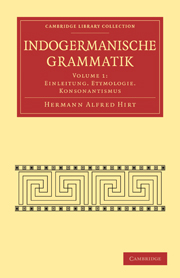Book contents
- Frontmatter
- Vorwort
- Contents
- Literaturangaben
- Verzeichnis der Abkürzungen
- Einleitung
- Erster Teil. Etymologie
- XI. Kapitel Die Lautlehre
- XII. Kapitel Grundgesetze der etymologischen Forschung
- XIII. Kapitel Die Bedeutung der Wörter
- XIV. Kapitel Verwandte und entlehnte Wörter
- XV. Kapitel Verlust von Worten
- XVI. Kapitel Etymologie und Kulturgeschichte
- Zweiter Teil. Der idg. Konsonantismus
- XVII. Kapitel Die Sonorlaute
- XVIII. Kapitel Die Zischlante
- XIX. Kapitel Idg. j und w
- XX. Kapitel Die idg. Tenues und Mediä
- XXI. Kapitel Die idg. Mediä aspiratä
- XXII. Kapitel Die Lautverschiebung
- XXIII. Kapitel Das Hauchdissimilationsgesetz im Griechischen und Indischen
- XXIV. Kapitel Die Gutturalreihen
- XXV. Kapitel Die Tenues aspiratä
- XXVI. Kapitel Sonstige Laute des Idg
- XXVII. Kapitel Konsonantenverbindungen
- XXVIII. Kapitel Die r-Verbindungen
- XXIX. Kapitel Die l-Verbindungen
- XXX. Kapitel Die n-Verbindungen
- XXXI. Kapitel Die m-Verbindungen
- XXXII. Kapitel Die w-Verbindungen
- XXXIII. Kapitel Die j-Verbindungen
- XXXIV. Kapitel Die s-Verbindungen
- XXXV. Kapitel Veränderungen des Konsonantenstandes im Idg. Schwund von Konsonanten
- XXXVI. Kapitel Konsonantenwechsel
- XXXVII. Kapitel Auslautsgesetze
- XXXVIII. Kapitel Der Anlaut
- Autorenverzeichnis
- Sachverzeichnis
- Wörterverzeichnis
XX. Kapitel - Die idg. Tenues und Mediä
Published online by Cambridge University Press: 05 August 2011
- Frontmatter
- Vorwort
- Contents
- Literaturangaben
- Verzeichnis der Abkürzungen
- Einleitung
- Erster Teil. Etymologie
- XI. Kapitel Die Lautlehre
- XII. Kapitel Grundgesetze der etymologischen Forschung
- XIII. Kapitel Die Bedeutung der Wörter
- XIV. Kapitel Verwandte und entlehnte Wörter
- XV. Kapitel Verlust von Worten
- XVI. Kapitel Etymologie und Kulturgeschichte
- Zweiter Teil. Der idg. Konsonantismus
- XVII. Kapitel Die Sonorlaute
- XVIII. Kapitel Die Zischlante
- XIX. Kapitel Idg. j und w
- XX. Kapitel Die idg. Tenues und Mediä
- XXI. Kapitel Die idg. Mediä aspiratä
- XXII. Kapitel Die Lautverschiebung
- XXIII. Kapitel Das Hauchdissimilationsgesetz im Griechischen und Indischen
- XXIV. Kapitel Die Gutturalreihen
- XXV. Kapitel Die Tenues aspiratä
- XXVI. Kapitel Sonstige Laute des Idg
- XXVII. Kapitel Konsonantenverbindungen
- XXVIII. Kapitel Die r-Verbindungen
- XXIX. Kapitel Die l-Verbindungen
- XXX. Kapitel Die n-Verbindungen
- XXXI. Kapitel Die m-Verbindungen
- XXXII. Kapitel Die w-Verbindungen
- XXXIII. Kapitel Die j-Verbindungen
- XXXIV. Kapitel Die s-Verbindungen
- XXXV. Kapitel Veränderungen des Konsonantenstandes im Idg. Schwund von Konsonanten
- XXXVI. Kapitel Konsonantenwechsel
- XXXVII. Kapitel Auslautsgesetze
- XXXVIII. Kapitel Der Anlaut
- Autorenverzeichnis
- Sachverzeichnis
- Wörterverzeichnis
Summary
Idg. p ist im allgemeinen erhalten geblieben. Nur das Keltische und Armenische haben es nicht bewahrt, sondern ea zunächst in h verwandelt, worauf es weiter geschwunden ist.
Gr. παλάμη ‘flache Hand’, l. palma, air. lām, aw. p∂r∂nā ‘hohle Hand’, ai. pāṇis;
gr. πετάννυμι ‘breite aus’, l. pateo ‘stehe offen’, lit. petĩs ‘Schulter’.
gr. πατήρ, l. pater, air. athir, arm. hair, ai. pitā;
gr. πούς, l. pēs, lit. pēdà ‘Fußspur’, abg. podŭ ‘Boden’, ai. pād ‘Fuβ’.
Anm. Merkwürdigerweise scheinen die Labiale der Aussprache Schwietigkeiten zu bereiten. p schwindet anlautend im Arm. und Kelt., b war im Idg. nur schwach vertreten. Anlautendes p war im Idg. allerdings recht häufig.
Idg. b. Idg. b ist zweifellos verhältnismäßig selten gewesen, wenngleich es nicht angeht, den Laut völlig zu leugnen, wie man früher getan hat. Im ersten Teil von Ficks Vergl. Wb. fehlt z. B. anlautendes b.
Beispiele:
gr. βελτίων, βέλτερος ‘besser’, l. dē-bilis ‘schwach’, abg. bolĭjĭ ‘gröβer’, ai. bálījān ‘stärker’, bálam n. ‘Kraft, Stärke, Gewalt’;
gr. βάκτϱον, l. baculum ‘Stab, Stütze’;
gr. ἀ-βακής ‘löricnt’. l. imbēcillus;
gr. βάρβαρος, lit. barbôž'us ‘Summer’, serb. brbljati ‘plappern’;
l. balbus ‘stammelnd, lallend’, tschech. blb ‘Tölpel’, serb. blebetati, lit. blebēnti ‘plappern’;
gr. βαῦζω ‘belle, schmähe’, l. baubor ‘belle’, lit. baūbti ‘brüllen vom Rind’;
l. bucca ‘die aufgeblasene Backe’, gr. βύκτης ‘heulend’, abg. bučati ‘brüllen’, abg. bykŭ ‘Stier’, lit. bùkč'us ‘Stammler’;
gr. βόλβος, ‘Zwiebel’, l. bulbus (entlehnt?), lit. bulbē ‘Kartoffel’.
Im Inlaut ist b häufiger.
[…]
- Type
- Chapter
- Information
- Indogermanische Grammatik , pp. 214 - 216Publisher: Cambridge University PressPrint publication year: 2009First published in: 1927



